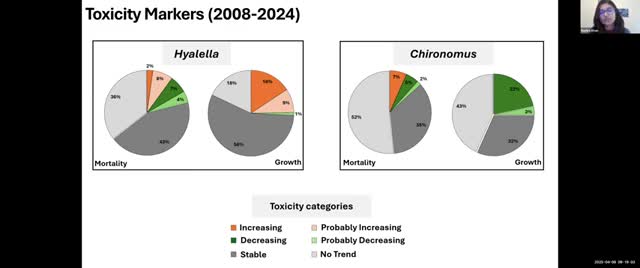Environmental study identifies 28 toxic sites using new growth markers
April 26, 2025 | California Water Quality Monitoring Council, Boards and Commissions, Executive, California
This article was created by AI summarizing key points discussed. AI makes mistakes, so for full details and context, please refer to the video of the full meeting. Please report any errors so we can fix them. Report an error »

The recent meeting of the California Water Quality Monitoring Council highlighted significant findings regarding water toxicity levels across various sites in the state. The discussions centered on the use of toxicity markers, which serve as essential tools for prioritizing monitoring efforts at locations showing concerning levels of contamination.
During the meeting, experts presented data indicating that nine sites exhibited increasing toxicity levels, while ten sites showed a decrease. The analysis utilized two key species—the freshwater amphipod and midge larva—to assess toxicity through survival and growth markers. Notably, the data revealed that 22 sites were identified as increasing in toxicity based on growth metrics, underscoring the importance of these markers in detecting sublethal effects on aquatic life.
The findings also emphasized the value of using multiple organisms in toxicity testing. By incorporating the midge larva into the assessment, three additional sites were identified as toxic, demonstrating that a broader range of indicators can enhance the detection of environmental hazards. The overlap in toxicity data between different species suggests a complex mix of chemicals affecting these organisms, which is crucial for understanding the overall health of aquatic ecosystems.
The meeting further discussed the correlation between urban land use and toxicity levels, reaffirming previous findings that urban areas tend to have higher toxicity rates. However, no significant trends were observed for the midge larva in relation to land use, indicating that further investigation may be necessary to understand the factors contributing to toxicity in these environments.
As part of ongoing efforts to monitor water quality, the Council plans to implement an alternate year cycle for sites that have consistently shown non-toxic results. This strategy aims to optimize resource allocation while ensuring that potentially problematic sites receive the attention they require.
In conclusion, the discussions at the California Water Quality Monitoring Council meeting reflect a commitment to improving water quality monitoring and addressing the impacts of pollution on local ecosystems. The findings not only inform future monitoring strategies but also highlight the importance of community awareness regarding water safety and environmental health.
During the meeting, experts presented data indicating that nine sites exhibited increasing toxicity levels, while ten sites showed a decrease. The analysis utilized two key species—the freshwater amphipod and midge larva—to assess toxicity through survival and growth markers. Notably, the data revealed that 22 sites were identified as increasing in toxicity based on growth metrics, underscoring the importance of these markers in detecting sublethal effects on aquatic life.
The findings also emphasized the value of using multiple organisms in toxicity testing. By incorporating the midge larva into the assessment, three additional sites were identified as toxic, demonstrating that a broader range of indicators can enhance the detection of environmental hazards. The overlap in toxicity data between different species suggests a complex mix of chemicals affecting these organisms, which is crucial for understanding the overall health of aquatic ecosystems.
The meeting further discussed the correlation between urban land use and toxicity levels, reaffirming previous findings that urban areas tend to have higher toxicity rates. However, no significant trends were observed for the midge larva in relation to land use, indicating that further investigation may be necessary to understand the factors contributing to toxicity in these environments.
As part of ongoing efforts to monitor water quality, the Council plans to implement an alternate year cycle for sites that have consistently shown non-toxic results. This strategy aims to optimize resource allocation while ensuring that potentially problematic sites receive the attention they require.
In conclusion, the discussions at the California Water Quality Monitoring Council meeting reflect a commitment to improving water quality monitoring and addressing the impacts of pollution on local ecosystems. The findings not only inform future monitoring strategies but also highlight the importance of community awareness regarding water safety and environmental health.
View full meeting
This article is based on a recent meeting—watch the full video and explore the complete transcript for deeper insights into the discussion.
View full meeting
